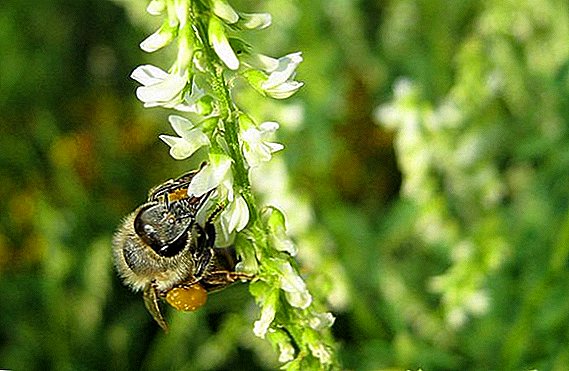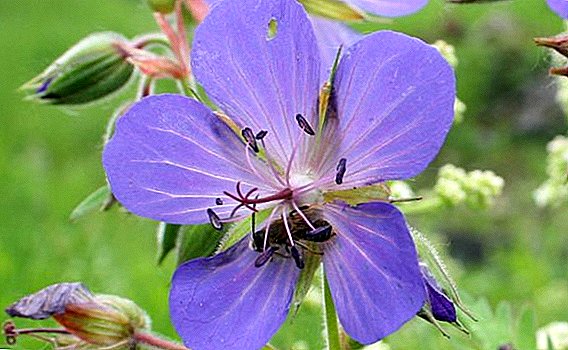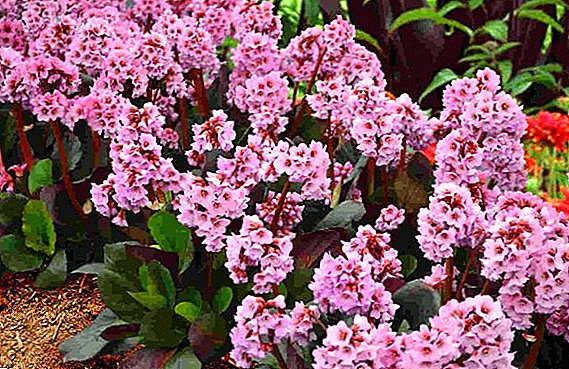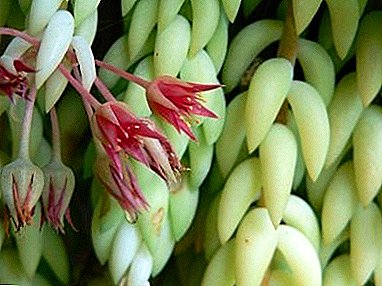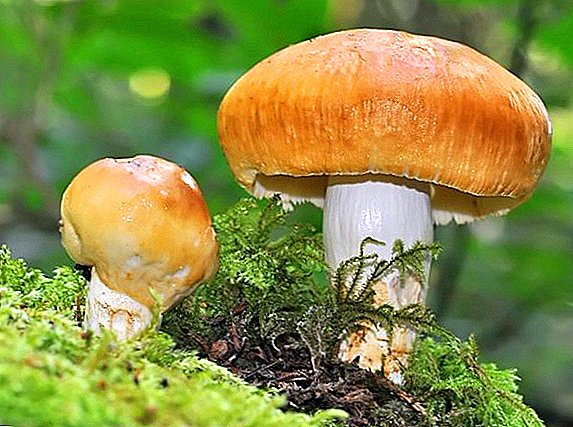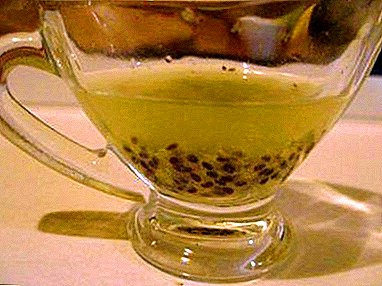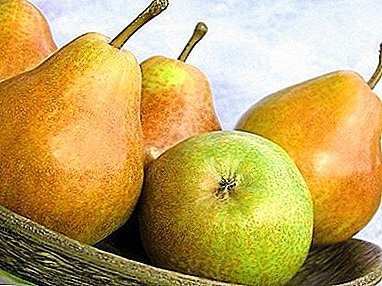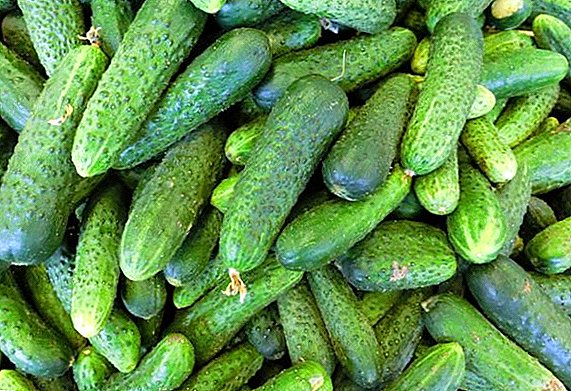 In the cucumber world, its creators greatly appreciate the taste qualities of vegetables, the possibilities of their realization on the market, including the wholesale market, and their protection from the diseases characteristic of these plants.
In the cucumber world, its creators greatly appreciate the taste qualities of vegetables, the possibilities of their realization on the market, including the wholesale market, and their protection from the diseases characteristic of these plants.
That is why the variety "Claudia-f1" is deservedly popular among summer residents, gardeners and farmers.
Variety description
Cucumbers of this hybrid variety, included in the botanical classification, in the pumpkin family, grow up with whips, long and powerful.
The hybrid varieties of cucumbers include such as "Spino", "Shosh", "Siberian garland", "Aquarius", "Emerald earrings", "Cedric".
Juicy green leaves, with wrinkles. The plant is self-pollinated. The predominant type of flowering is female (all flowers become fruits, but there are no specimens blooming for nothing). Ovaries are laid tufts. 
Advantages that distinguish the "Claudia-f1" from other varieties:
- hybridization resulted in stable disease resistance;
- grows well in the open air and in the greenhouse;
- the crop has a long-lasting presentation and is normally transported;
- canned by any technology, aided by the relatively small size of the fruit.
Especially significant deficiencies have been identified, but still:
- cucumber foliage can get burns from prolonged exposure to direct sun;
- against the general background of disease immunity, “Claudia-f1” can still not resist the attack of powdery mildew and certain forms of mosaic.
Did you know? The presence in the name of this variety of the marker f1 means that we are talking about a hybrid form, which means a plant with improved properties. This variety is relatively young - the result of the painstaking work of breeders was officially recognized in 1999, when this hybrid gained its place in the Russian state register.

Fruit characteristics and yield
Medium length (10-12 cm), not too pot-bellied (diameter up to 3.5 cm) and rather weighty (average weight - from 80 to 90 g) cylindrical dark green fruit slightly covered with tubercles on a smooth surface.
It’s nice to eat a freshly picked Claudia-f1 cucumber: light crunch, fresh smell, taste of dense pulp without bitterness.
The harvest begins to ripen six weeks after the emergence of the seedlings, that is, the variety is middle-ripening (here specialists have discrepancies - such a growing season allows some to classify these cucumbers as early-ripening).
Guaranteed collection of 10 kg of cucumbers per square meter of vegetable garden in the open field and twice the yield from the beds in greenhouse conditions: this will satisfy the most demanding gardener. 
Selection of seedlings
Those who do not wish to bother themselves with growing their own seedlings should visit the market or the store - the market row or outlet should be for special purposes.
In short, you need to pay attention to:
- the number and color of leaves - up to 4 inclusive and dark green;
- height of shoots - up to 15 cm;
- lack of swelling on the lower foliage.
Such an option is sufficient for an experienced gardener, since the rest of his conditions are already on the note.
Beginners should be instructed in more detail:
1. For cultivation in different conditions you need to purchase and seedlings of different age:
- the oldest is for heated greenhouses;
- middle age - for greenhouses, not supplied with heating;
- the youngest is for planting in open ground.

2. Attention to the container in which the seedlings are sold: the pots must be intact. In addition, with increasing plant age should increase and the volume of the tank in which it is contained. Finally, it must be borne in mind that during planting you can remain without a part of the root system, if its shoots have already crawled into the pan from the lower pot hole.
3. In the case of buying bulk seedlings, the focus is on the roots - they must be flawless.
4. On the seedlings themselves, the presence of any garden pests, their larvae, or even traces is not permissible, which may be, in particular, no one knows where the defects or thickenings (thinning) come from.
Important! Do not forget to inspect the leaves below. - This is where sources of disease nest often.

5. Cucumber "Claudia-f1" cucumbers do not like an excess of nitrogen - the use of seedlings by the implementers of this substance for accelerated growth will be evidenced by the twisting down of leaves that have a characteristic bright green color.
6. Do not take a seedling, in which the stems are too elongated, and the leaves are too small and have a pale appearance - it certainly was contained in violation of the regime norms, and you, risking to make such an acquisition, do not wait for a good harvest.
7. Make sure that the seedlings that you intend to plant immediately in open ground have undergone a preliminary hardening procedure - as a result of which they have not received additional carbohydrates and a strengthened root system, cucumbers will not be able to withstand weather changes and other stresses. The consequence is a decrease in yield.
Soil and fertilizer
Soil for planting cucumbers "Claudia-f1" should be acid-neutral, saturated, but without significant nitrogen content.  Sour soil is recommended to aggravate (with lime powder, slaked lime, wood ash, etc.). Drainage is required.
Sour soil is recommended to aggravate (with lime powder, slaked lime, wood ash, etc.). Drainage is required.
Soil enrichment is carried out in two stages:
- In the autumn, after digging (to a depth of 15 cm) of the vegetable garden harvested from the crop, add manure (5 kg), ash (glass) and superphosphate (a tablespoon) to each square meter of the future cucumber bed, and top with a copper sulphate, dissolve a tablespoon in decaliter of water.
- In the spring, having determined that a landing will take place in a week, again use manure (or humus) - 2.5 kg and a glass of ash (per square meter), and dig this time 10 cm deeper than in the fall.
There is no need to take the beds where relatives of the pumpkin family were grown before: zucchini, watermelons, melons, pumpkins themselves, other cucumber varieties and other similar plants, of which there are about 900 species on a global scale, united in 130 genera. 
Did you know? Man began to cultivate pumpkin varieties thousands of years ago. Watermelons, in particular, were included in the menu of the ancient Egyptians. But cucumbers got on the table to a man when the ancient Greeks and Romans got carried away with them.
But, having replaced potatoes, cabbage, beans (and other legumes) with cucumbers on the garden soils, you can not be afraid of a possible decrease in yield.
Growing conditions
Experience has shown that these vegetables are able to live in any conditions, within reason. But it will be preferable to place the beds for them where there will be a lot of unshadowed sun, from which the foliage will need to be protected from the long exposure to direct rays (during especially hot periods).
The warming of the soil at the time of planting should be in the range of + 12-15 ° C. 
Humidity of the environment does not play a significant role, unless, of course, it is not always 100 percent or zero.
Growing from seed to seedlings at home
Those who do not trust the purchase of seedlings, do not want to spend on it extra money, wants to gain their own experience or apply the accumulated earlier, we suggest (recall) the sequence of home growing it.
It will be useful for you to learn how to grow cucumber seedlings correctly, when to plant cucumbers on seedlings, and how to seed cucumbers correctly in a greenhouse.
Seed preparation
First, you need to learn that for the future significant harvest you need to use planting material of optimum age, which is 2 and 3 years - your "Claudia" from such seeds will grow with the largest number of ovaries.
Important! To use one-year seeds, they need to be stored before planting with increased, up to + 25-35°C, temperature, and three hours before the procedure - warm in the oven at 50° temperature

Returning to the best option, we observe and here dryness and heat for storing the material wrapped in paper or cloth.
The viability of seeds is determined using simple verification - we lower them into a salt solution (50 g / liter) for a third of an hour, after which we select only those that remain at the bottom of the tank and thoroughly wash them with water.
This is followed by disinfection.
It is simple and exists in three versions:
- Manganese water solution (10 g / liter) - the seeds are immersed in it for 20 minutes, and after the procedure they are washed.
- Daily soaking of planting material in streptomycin solution (50 units / ml of water).
- Half-hour soaking in garlic solution, filtered through cheesecloth (1 clove / 0.8 l of water).

The next operation is intended to speed up the process of subsequent germination of seeds - their semi-daily content in a liter of an aqueous solution of copper sulphate and nitrophosphate (diluted with a teaspoon of each preparation in hot water).
Finally, you can resort to the preliminary germination of seeds in order to increase their germination.
The recipe is:
- Daily soaking of seeds in a special solution that exists in three variations: either 20 g of boric acid, or 2 g of zinc sulphate, or 5 g of baking soda - per liter of water.
- The daily content, after soaking, where the positive temperature is maintained from 20 to 25 ° C - while the material itself must be packed in a damp cloth, and on top - in a plastic bag.
The consequence of this procedure will be the emergence from the swollen seeds of the endings of small roots. 
Important! Do not overdo it with the duration of the process - otherwise the roots will stretch too much and may break during planting.
The maintenance, location, planting seeds and seedling care
By April, you should have prepared the necessary number of 12-centimeter cups. Before planting, they are filled with soil mixture (sawdust, humus and peat in a ratio of 1: 2: 1), to which additives are also made - ash and nitrophoska (respectively 2 and 1.5 tablespoons per 4 kg of soil).
The room temperature should be maintained at + 25 ° C.
After the seeds are in a cooked container at a depth of 2 cm, they need to be sprinkled on top, and the cups should be covered with plastic wrap, which will need to be removed when shoots appear. 
Abundant watering of the seedlings is carried out every five days with a solution of nitrophoska (a teaspoon per liter of water) - the beginning of this process is the appearance of a third leaf in sprouts.
The 5th leaf, together with the 20-centimeter height reached by the sprouts, serves as a signal that the time has come to change the location to open ground.
Transplanting seedlings to ground
The sequence of these actions, starting in late May - early June, looks like this:
- Wells are made according to the scheme 35 x 50 cm, where the first number is the distance between the holes, and the second is between the rows.
- Even before the seedlings, the wells are watered with half-liters of manganese solution (0.5 g / 10 l).
- After placing the sprouts in the wells, they are filled up so that the semi-nuclear knee remains open.
- Then follows a second watering with the same amount of solution.

Important! Roots of cucumbers, especially in seedlings, are extremely fragile. - be careful.
Agrotechnics growing seeds in open ground
Whatever seedless variant of cucumber cultivation (greenhouse or vegetable garden) you choose, the further technological process is the same for them.
Outdoor conditions
A greenhouse (greenhouse) is more profitable for a gardener in a material sense - due to this, the yield can be doubled. But in the same sense, there is the opposite circumstance - the cost of maintaining greenhouses exceed the corresponding resources spent on an open garden.
As for the first stage of work in the open field, the choice of location is due to the need for good illumination of cucumber beds - it is necessary to avoid the presence of structures and greenery near them, giving a significant shade. 
The process of planting seeds in the ground
The deadline for planting seeds comes at the beginning of June (the last decade of May), when the garden soil is already well warmed up (the optimum temperature is + ° C degrees).
You need to do the following:
- Perforate the beds at a depth of 5 cm.
- Pour over a warm degree to 40 with water.
- Arrange the seeds in pairs in 15 cm and sprinkle with earth.
Another option (nested) looks like this:
- A high (25 cm) and wide (up to a meter) bed is being made.
- Sowing of seeds on it is done in two rows, the distance between which is maintained at about 15 cm.

Watering
If the weather is favorable, that is, it brings every day heat and moisture, then watering is not necessary. Careful observation in the hot period for cucumber leaves will allow you to catch the moment when there is a need for watering - the leaves start to wither.
The watering itself is done with a watering can - this method allows you to grab a wide area and not to soil the soil near the roots.
Important! Water on the leaves is extremely undesirable. - drip lenses can cause sunburn.
Terms of watering the following:
- in the heat - daily;
- in the absence of the sun - weekly.
Water flow - 3 liters per bush. 
Soil loosening and weeding
The root system needs air - they will get the right amount as a result of weekly soil loosening. It should not be allowed to dry to the level of formation of a crust - it is necessary to loosen after watering or, if possible, after precipitation, then the ground moisture lasts longer, not evaporating quickly.
Do not forget the interrow space - work with the hoe there too, focusing on approximately 10 centimeters depth.
Weeds should not interfere with the growth of the future harvest - regular weeding is necessary as they appear.
Masking
Masking with cucumbers is not critical. In relation to the "Claudia-f1" it is made with the aim of not allowing the side shoots to be more than half a meter in length, and the processes from them - 15 cm (with a meter length of the main whip). 
The procedure itself needs accuracy - if the fingers are not accustomed to it, it would be better to use scissors.
Garter
Long lashes of plants of this variety (although agricultural specialists in this case speak of average weaving) necessitated the use of tying (except for the already mentioned staving as a method of forming a bush).
The importance of this operation is to prevent, firstly, the overgrowth of the liana, which takes a lot of vitality from the plant, and secondly, the falling away of the ovaries, which are not kept on an excessively long stem.
Garter is done in two main ways - horizontal and vertical, as well as a hybrid combination of both. 
Without going into details, we turn your attention to the vertical version, since it is minimally dangerous in terms of possible damage to the plant and provides it with the maximum amount of light - the latter, as already noted, for "Claudia-f1" is of particular importance.
Top dressing
Growing cucumbers in two forms - root and foliar.
The first is for the fruiting season, it is done three times with a 10-day gap.
Each bush should receive every time one and a half liters of the mixture, calculated on the basis of water per decaliter:
- in the first case - a tablespoon of nitrophoska and a kilogram of manure;
- in the second - three and one tablespoons, respectively, of ash and urea, as well as a teaspoon of sodium humate;
- in the third - a tablespoon of agrofoski.

Three dressings are provided in the second form:
- one is carried out with an aqueous solution of potassium salt, superphosphate and nitrate (8, 10 and 5 g / 10 l) - a liter per bush during any growing season;
- the other two are made with a solution of urea, superphosphate and potassium sulfate (1 teaspoon of each drug per 10 liters of water) - 1.5 l / bush at the end of the first and second decade of June.
Pests, diseases and prevention
Even this, successfully coping independently with the attacks of pests and a painful infection, a varietal plant like "Claudia-f1" needs care, protecting it from negative influences.
Hedge aphid and whitefly, which suck the roots of the bear and the cucumber mosquito, the spider mite, germ fly and slug, can harm the plantings, and damage to the landings. 
Warn their attacks should be through regular inspection of the future harvest, timely loosening of the soil and weeding, deep spring digging of the beds.
It is necessary to combat pests that have already appeared with the help of chemical agents acquired in specialized retail outlets and the mechanical processing of plants, together with the creation of obstacles for the attacked insects from the improvised material (sand, boards, slate, crushed eggshell, etc.).
Of the diseases mentioned above, mosaic (white and green) and powdery mildew are a threat. It is not excluded the appearance of root rot. For the prevention of the latter, it is recommended that cucumbers should not be spud and only be watered with warm water.
For powdery mildew obstacles will be the observance of the rules of agrotechnology and the immediate removal of the affected leaves. For the prevention of mosaic will require careful weeding, the fight against aphids and the complete removal of infected plants. 
They struggle with these diseases, in addition to clearly following the rules of cultivation, also with colloidal sulfur (in the case of powdery mildew), milky solution with low fat content (for mosaic), copper sulphate, chalk and ash (against root rot).
Harvesting and storage
The usual regularity of harvesting is once every three days, although small delays are quite acceptable. When the fruits start arriving en masse, the intervals should be reduced to two days, or even to one. The beginning of the harvesting gardeners determine each independently - a single recipe does not exist.
For cleaning use morning and evening hours, using knives or pruners. The harvested crop is immediately placed in the cool, or simply covered from above (not by film - it will create the effect of generating unnecessary heat).
Important! The stem should remain on the stem, and the shoots and mustache - intact.

Fresh cucumbers do not withstand long-term storage - a month in the refrigerator is considered to be quite a sufficient period, although there are sophisticated ways to prolong it - with the help of raw egg white, grated or chopped horseradish. In the latter case, the cucumbers are first washed and then dried.
Washing, or rather, soaking the fruit in water, is practiced in order to prepare them for canning.
Possible problems and recommendations
Perishing foliage, as a problem, is characteristic not only of Claudia-f1, but also of other cucumber varieties.
It can be caused, first of all, by lack of moisture, sunburn, stress (its greenhouse climate can, in particular, provoke, as well as a sharp change in the weather), inappropriate growing neighborhood (with tomatoes, for example), excessive height and beds, violation of instructive requirements for the use of fertilizers, finally, the diseases already mentioned. 
Similar factors influence the fall of cucumber fruits. A special feature is that this is mainly subject to small cucumbers.
In any case, there is no need to be frightened; there will always be a way out of this situation, the main thing is to clearly establish the cause of the phenomenon.
"Claudia-f1" gives you much more pleasure than the hassle. We do not deal with this variety, we advise you to try, and those who cultivate it are recommended to continue.


